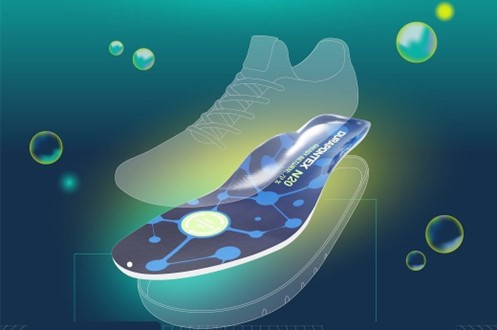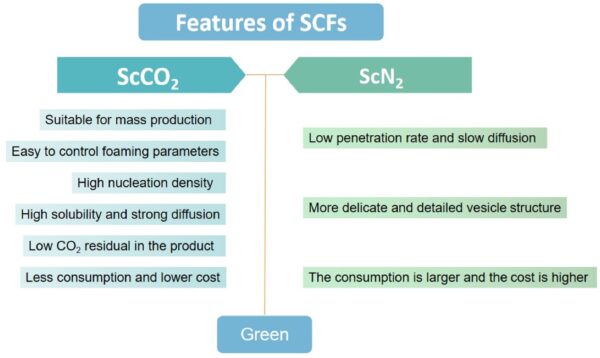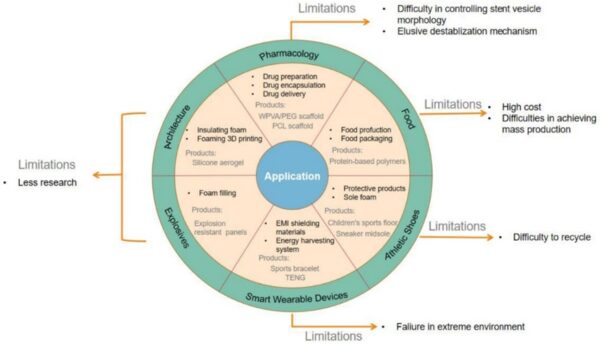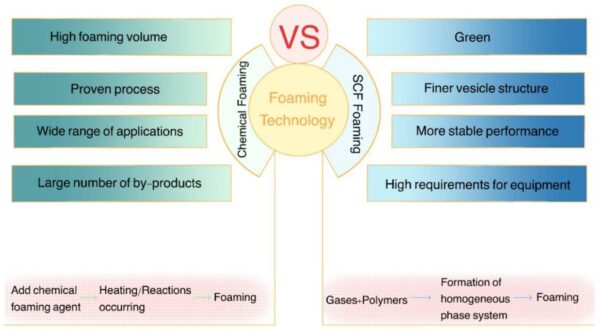Understanding Supercritical Foaming Technology

Supercritical foaming revolutionizes polymer science, creating lightweight, porous materials with superior properties through controlled pressure and supercritical fluids.
With the global emphasis on sustainable development and environmental conservation, the demand for greener chemical processes has never been more critical. Despite this backdrop, supercritical foaming technology stands out as a light of hope, promising to address the challenges created by conventional polymer foam production methods. By utilizing supercritical fluids (SCFs) as foaming agents, particularly supercritical carbon dioxide (ScCO2) and supercritical nitrogen (ScN2), this innovative technology not only enhances foam production efficiency but also significantly reduces its environmental footprint.
You can also read: Anticipating Change: The Move to Siloxane-Free PPAs
Exploring Supercritical Foaming (SF) Technology
Supercritical foaming technology represents a significant advancement in the field of polymer science and engineering. Unlike traditional chemical foaming methods, which often involve the use of toxic and environmentally harmful substances, supercritical foaming harnesses the power to create lightweight and porous polymer materials with exceptional properties such as smaller pore size, higher pore density, and better performance. The process involves subjecting polymers to SCF under controlled conditions of pressure and temperature, leading to the formation of uniform and finely structured foams.

Features of SF technology. Courtesy of Applications and Challenges of Supercritical Foaming Technology.
Applications In The Industry
Food industry
In the food industry, supercritical fluids enhance production and packaging processes. While supercritical extraction improves food quality, SF, although less common, shows promise in producing protein-based polymers like egg white protein (EWP).
Factors such as protein concentration and pH affect the foaming properties of EWP, which techniques like heat treatment can enhance. The food packaging industry favors thermoplastic polymer foam, especially polypropylene (PP) foam, for its insulation and recyclability. However, challenges persist with traditional materials like expanded polystyrene (EPS), driving exploration into alternatives such as carvacrol (CRV) for antibacterial properties.
Athletic Shoe Industry
Supercritical foam technology has garnered attention in the development of foam materials for sneaker manufacturing. Ethylene-vinyl acetate copolymer (EVA) stands out as a widely adopted material due to its lightweight, softness, non-toxicity, and cost-effectiveness. Nevertheless, challenges such as harmful residues, poor elasticity, and environmental pollution persist with conventional foams like EVA. Thermoplastic polyurethane bead foam (ETPU) emerges as a viable alternative, offering environmental friendliness, heat and wear resistance, and high resilience.
Advancements in Smart Wearable Devices through Supercritical Foaming (SF) Technology
Supercritical foaming technology finds extensive application in the development of smart wearable devices, especially in addressing challenges related to electromagnetic interference (EMI) shielding and heat management. Lightweight, flexible composite materials, incorporating elements like silicone rubber and silver-plated hollow glass microspheres, demonstrate promise in EMI shielding for wearable electronics. Moreover, advancements in piezoelectric materials enable the development of self-powering electronic devices, leveraging polyvinylidene fluoride (PVDF) foam’s porous structure to harvest mechanical energy from the environment. Despite these advancements, there is a need for further research to optimize polymer foam performance under extreme environmental conditions.

Applications of SF technology. Courtesy of Applications and Challenges of Supercritical Foaming Technology.
Advantages of Supercritical Foaming (SF)
The adoption of this technology offers notable advantages:
- Environmental Friendliness: By employing non-toxic and environmentally benign SCFs such as ScCO2 and ScN2, supercritical foaming minimizes the release of harmful chemicals into the environment, contributing to sustainable manufacturing practices.
- Enhanced Control and Customization: SF provides fine control over the foaming parameters, allowing producers to adjust foam qualities to suit application requirements. From pore size to density, the technique provides unmatched customizing options.
- Versatility and Application Range: The versatility of SF technology extends across various industries, including food packaging, pharmaceuticals, composite materials, and footwear manufacturing. Its ability to produce foams with superior mechanical properties makes it an attractive choice for diverse applications.
- Cost-Effectiveness and Efficiency: Despite initial setup costs, supercritical foaming technology is cost-effective due to its improved manufacturing processes and lower resource use.
Current Trends and Challenges

Trends and challenges of SF technology. Courtesy of Applications and Challenges of Supercritical Foaming Technology.
While supercritical foaming technology holds promise, certain challenges remain to be addressed, these include:
- Scaling Up Production: Although researchers have successfully implemented SF technology in laboratory settings, scaling it up for large-scale industrial production requires overcoming logistical and technical challenges. The Integration with other manufacturing processes yields advanced materials and functional devices.
- Control of Foam Properties: Achieving precise control over foam properties, such as pore size distribution and foam density, remains a key area of focus for researchers and manufacturers.
- Recycling and Waste Management: Developing effective recycling mechanisms for waste foam products is essential to ensure the sustainability of SF technology.
- Enhance foam control and application: Researchers refine parameters, techniques, and materials to enhance foam control and application versatility.
